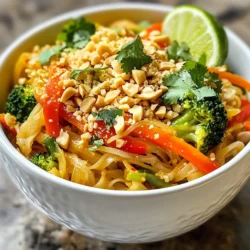WANT TO SAVE THIS RECIPE?
Are you ready to transform your dinner routine? This Veggie Loaded Pad Thai is flavorful, healthy, and packed with fresh veggies. I’ll guide you through easy steps to create a dish that’s not only delicious but also quick to make. Whether you’re a beginner or an expert in the kitchen, this recipe will satisfy your cravings and keep you on the right track with your health goals. Let’s dive in!
Why I Love This Recipe
- Healthy and Nutritious: This Veggie Loaded Pad Thai is packed with colorful vegetables, providing essential vitamins and minerals in every bite.
- Quick and Easy: This recipe can be prepared in just 30 minutes, making it a perfect choice for a busy weeknight dinner.
- Customizable: You can easily swap in your favorite veggies or proteins, making it adaptable to your personal taste preferences.
- Delicious Flavor: The combination of tamarind, soy sauce, and peanut butter creates a rich and savory sauce that elevates the dish to another level.
Ingredients
List of Required Ingredients
– 8 oz rice noodles
– 1 cup bean sprouts
– 1 cup shredded carrots
– 1 red bell pepper, sliced
– 1 cup broccoli florets
– 3 green onions, chopped
– 2 cloves garlic, minced
– 2 tablespoons tamarind paste
– 2 tablespoons soy sauce
– 1 tablespoon hoisin sauce
– 1 tablespoon peanut butter
– 1 tablespoon sesame oil
– 1 tablespoon vegetable oil
– ¼ cup crushed peanuts (for topping)
– Fresh cilantro, for garnish
– Lime wedges, for serving
– Salt and pepper to taste
When I make Veggie Loaded Pad Thai, I love using fresh, colorful ingredients. First, the rice noodles are the base of this dish. They soak up all the flavors. I choose 8 ounces. Then, I add a mix of fresh vegetables. I like to use bean sprouts, shredded carrots, sliced red bell pepper, and broccoli florets. These veggies not only add crunch but also make the dish healthy.
For the sauce, I use tamarind paste, soy sauce, hoisin sauce, and peanut butter. This mix gives the Pad Thai a rich taste. I also add sesame oil and vegetable oil to stir-fry the veggies. Don’t forget salt and pepper to bring everything together.
Finally, I love to garnish my dish with crushed peanuts and fresh cilantro. Lime wedges on the side add a nice zing. These ingredients make this Pad Thai not just tasty but also fun to eat!

Step-by-Step Instructions
Preparation of Noodles
To start, you need to prepare the rice noodles. Follow the package instructions for soaking and cooking. Usually, this involves boiling water and letting the noodles soak until soft. Once done, drain them well and set aside. This helps the noodles stay loose and ready for the stir-fry.
Cooking the Vegetables
Now, let’s heat the oils. In a large wok or skillet, pour in vegetable oil and sesame oil. Turn the heat to medium-high. Add minced garlic, stirring for about 30 seconds. You want it to smell good but not burn.
Next, toss in the sliced red bell pepper and broccoli florets. Stir-fry these for about 2-3 minutes. You want them to soften but still stay crisp. Then, add the shredded carrots and continue to stir-fry for another 2 minutes. This adds color and flavor to your dish.
Combining Everything
Now it’s time to bring everything together. Push the veggies to the side of the wok. Add the drained noodles to the center.
In a small bowl, mix tamarind paste, soy sauce, hoisin sauce, and peanut butter. Blend it well until smooth. Pour this sauce over the noodles. Toss everything together until the noodles are well-coated and heated through.
Finally, add the bean sprouts and chopped green onions. Toss for another 1-2 minutes to mix well. Season with salt and pepper to taste. Now your Veggie Loaded Pad Thai is ready! Serve it hot, topped with crushed peanuts and fresh cilantro. Don’t forget the lime wedges for a zesty touch!
Tips & Tricks
Cooking Tips
– To stop noodles from sticking, rinse them in cold water. This cools them down and keeps them separate.
– Use a mix of sesame oil and vegetable oil for stir-frying. This combo adds flavor and helps with high heat.
Flavor Enhancements
– If you like heat, add chili flakes or fresh chilis. Start with a little and taste as you go.
– For protein, mix in tofu, chicken, or shrimp. These options make the dish heartier.
Presentation Tips
– Serve the Pad Thai in a large bowl for a cozy look. This invites people to dig in.
– Top with crushed peanuts and fresh cilantro. Lime wedges add a pop of color and flavor.
Pro Tips
- Cook Noodles Al Dente: Make sure to cook your rice noodles just until they are al dente. This helps them maintain their texture when stir-frying.
- Use Fresh Veggies: For the best flavor and crunch, use fresh, seasonal vegetables. They add vibrant colors and enhance the taste of the dish.
- Customize Your Protein: Feel free to add tofu, shrimp, or chicken for extra protein. Just make sure to cook the protein before adding the noodles.
- Adjust the Sauce: Don’t hesitate to adjust the sauce ingredients based on your taste preferences. A little more tamarind can add tang, while more peanut butter adds creaminess.

Variations
Protein Substitutions
You can add protein to your Veggie Loaded Pad Thai in different ways. Tofu is a great choice. It soaks up flavors well and adds a nice texture. Use firm or extra-firm tofu for the best results. Press it to remove extra water, then cut it into cubes.
Tempeh is another protein option. It has a nutty flavor and is rich in protein. Slice it thinly and sauté it until golden brown. Seitan is also a good option for those who want a meat-like texture. It cooks quickly and has a chewy bite.
Vegetable Alternatives
Feel free to switch up the veggies based on what you have. Seasonal vegetables can make your Pad Thai fresh and exciting. Try zucchini, snap peas, or mushrooms for different flavors.
You can also explore different textures. Add crunchy water chestnuts for a nice bite. If you want something softer, try sautéed spinach or cooked bok choy. Mixing veggies keeps the dish interesting and nutritious.
Sauce Modifications
Homemade sauces can take your Pad Thai to the next level. You can mix tamarind paste with lime juice and brown sugar for a fresh twist. This adds a nice tangy flavor.
If you need gluten-free options, use tamari instead of soy sauce. It has a similar taste but fits a gluten-free diet. You can also try coconut aminos for a sweeter flavor with less sodium.
Storage Info
Short-term Storage
For short-term storage, place leftovers in an airtight container. Keep the container in the fridge. The dish stays fresh for about 3 days. To keep flavors intact, avoid adding lime juice until serving. This way, the taste remains bright and fresh.
Long-term Storage
For long-term storage, you can freeze the Pad Thai. Divide it into portions and place them in freezer-safe bags. Make sure to remove air from the bags before sealing. It lasts up to 2 months in the freezer.
When you are ready to eat, thaw it overnight in the fridge. Reheat it in a pan over medium heat. Add a splash of water or a little oil to keep it moist. Stir frequently until it heats through. This keeps the noodles and veggies from becoming too dry.
FAQs
Is Pad Thai usually vegetarian?
Pad Thai is not always vegetarian. Many recipes use shrimp, chicken, or pork. However, you can make it meat-free. A veggie-loaded Pad Thai is just as tasty. When you swap meat for veggies, you boost health benefits. You get more fiber, vitamins, and minerals. The flavor stays rich with sauces and spices.
Can I make Pad Thai gluten-free?
Yes, you can! Use rice noodles as a base; they are naturally gluten-free. For sauces, choose gluten-free soy sauce. Brands like Tamari work well. Always check labels to avoid hidden gluten.
How can I add more vegetables?
Adding more veggies is easy. Here are some ideas:
– Use snap peas for crunch.
– Toss in mushrooms for earthy flavor.
– Add zucchini or yellow squash for color.
– Try baby corn for sweetness.
– Mix in spinach or kale for leafy greens.
These additions keep the dish colorful and packed with nutrients. You can also adjust cooking times so all veggies stay crisp and fresh.
This blog post covers the key steps to make delicious Pad Thai using rice noodles, fresh veggies, and flavorful sauces. You learned how to prepare and cook ingredients, combine everything for full flavor, and enhance your dish with tips on presentation and storage.
In the end, you can explore variations to suit your taste. Enjoy cooking and experimenting with this classic dis
Veggie Loaded Pad Thai
A delicious and healthy twist on traditional Pad Thai, loaded with fresh vegetables and flavorful sauces.
Prep Time 15 minutes mins
Cook Time 15 minutes mins
Total Time 30 minutes mins
Course Main Course
Cuisine Thai
Servings 4
Calories 350 kcal
- 8 oz rice noodles
- 1 cup bean sprouts
- 1 cup shredded carrots
- 1 red bell pepper sliced
- 1 cup broccoli florets
- 3 green onions chopped
- 2 cloves garlic, minced
- 2 tablespoons tamarind paste
- 2 tablespoons soy sauce
- 1 tablespoon hoisin sauce
- 1 tablespoon peanut butter
- 1 tablespoon sesame oil
- 1 tablespoon vegetable oil
- 0.25 cup crushed peanuts (for topping)
- 1 bunch fresh cilantro, for garnish
- 1 lime wedges, for serving
- to taste salt and pepper
Prepare the rice noodles according to the package instructions, then drain and set aside.
In a large wok or skillet, heat vegetable oil and sesame oil over medium-high heat.
Add minced garlic and sauté for about 30 seconds until fragrant.
Add the sliced bell pepper and broccoli florets; stir-fry for about 2-3 minutes until they start to soften.
Incorporate the shredded carrots and continue stir-frying for another 2 minutes.
Push the veggies to the side of the wok, and add the cooked noodles to the center.
In a small bowl, mix together tamarind paste, soy sauce, hoisin sauce, and peanut butter until well combined.
Pour the sauce over the noodles, mixing everything together until the noodles are coated and heated through.
Add the bean sprouts and chopped green onions, tossing everything for another 1-2 minutes.
Season with salt and pepper to taste, and remove from heat.
Serve hot, topped with crushed peanuts and fresh cilantro. Provide lime wedges on the side for squeezing over the Pad Thai.
Feel free to customize with your favorite vegetables or proteins.
Keyword healthy, noodles, Pad Thai, vegetarian
WANT TO SAVE THIS RECIPE?





